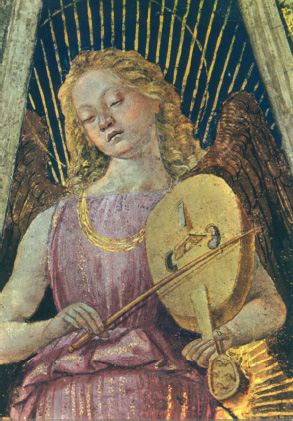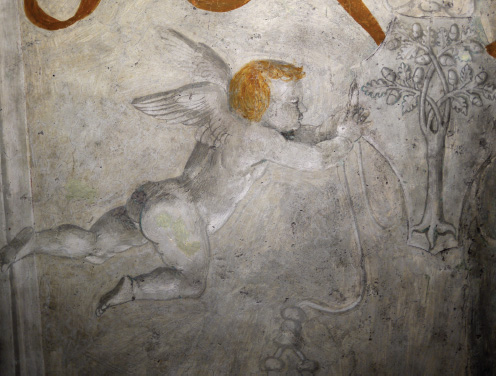![]()
A FIRST view of the great sanctuary at Loreto even now takes the breath away. This extraordinary complex, to which many of the great architects and painters of the Renaissance contributed, is as remarkable as the legend it celebrates. In 1291, as the Crusaders lost their hold on Palestine, the house in which the Virgin had been born and in which Christ was brought up after the return from Egypt was miraculously carried by angels to a hill near Fiume. On 10 December 1294 this was borne across the Adriatic to a laurel wood near Recanati, from where it was flown onwards to a farm owned by two brothers; their competing claims led to a final migration to the crest of a ridge on what was a public road, which after all was a not inappropriate site for a place of pilgrimage.
The small town that grew up on the approach to the sanctuary was incorporated within the splendid defensive walls built for Pope Leo X to the design of the younger Antonio da Sangallo and Andrea Sansovino, among others. Enter by the Porta Romana and follow the main street to the Piazza della Madonna, with a central fountain of 1604–14. On my first visit this was crowded with pilgrims, many in wheelchairs; Ursula Corning, who had worked in the New York hospital she helped to re-endow, looked on with a professional interest, trying to work out how many of the sick really believed they might be cured. The presence of ailing pilgrims reminds us that Loreto is in every sense a working shrine. On the left of the piazza is the colonnaded Palazzo Apostolico, begun by Bramante and worked upon by a sequence of later architects from Sangallo to Luigi Vanvitelli. Ahead, flanked on the left by Vanvitelli’s campanile of 1750–4, is the rich façade of the basilica itself, begun in 1571, and notable above all for the bronze reliefs of the doors; that in the centre is by the Lombardo brothers, that on the left, of 1596, by Tiburzio Vergelli and an assistant, while its counterpart was begun by Antonio Calcagni from Recanati and finished by other local masters in 1600.
The church is cruciform in plan. It was begun in 1468, and from 1476 the Florentine Giuliano da Maiano was in control, carrying the walls to full height. These were, however, reinforced for defensive purposes for Pope Innocent VIII, under whose Borgia successor, Alexander VI, work began on the octagonal dome designed by Giuliano da Sangallo, but strengthened by Francesco di Giorgio. Further work of consolidation was entrusted to Bramante (1509–11) and to Andrea Sansovino. Within the church it is the white marble Santissima Casa under the cupola that dominates the central axis. Encasing the original building, this was designed by Bramante, and is remarkable for its sculptured decoration. The large narrative reliefs of scenes from the life of the Virgin should be read from the left, north, wall. The most beautiful perhaps are those by Sansovino, the Annunciation of 1523 facing the nave and his Nativity on the south wall. The bronzes of the doors, by the Lombardo, Vergelli and Calcagni, are also distinguished.
At the angles of the crossing are four octagonal sacristies. That to the south-west, dedicated to San Marco, was frescoed from 1477 by Melozzo da Forlì. In the centre of the vault are the arms of Cardinal Girolamo Basso della Rovere, surrounded by bands of decoration, including eight compartments with angels holding musical instruments and symbols of the Passion, and below these eight more with prophets. The angels are perhaps Melozzo’s happiest achievements. Only one of the projected frescoes of the walls was painted, the Triumphal Entry to Jerusalem, much of which is by the young Marco Palmezzano. The south-east sacristy, dedicated to Saint John, is perhaps yet more memorable. Here the cardinal, who was responsible for the church from 1476 until 1507, called in the young Luca Signorelli. His arms once again are at the centre of the octagonal vault, in the segmental compartments of which are the Evangelists and the Doctors of the Church, each seated below a beautiful music-making angel. Below are the Conversion of Saint Paul, Christ and Saint Thomas, and pairs of Apostles. The cardinal’s arms, supported by paired putti, appear again in elegant grisaille above the door. Signorelli’s work at Loreto was no doubt the springboard that led to his selection to contribute to the Sistine Chapel.

Basilica, Sacristy of San Giovanni: Luca Signorelli, Evangelists and Doctors of the Church, with Angel Musicians, fresco (detail).
A door from the left transept leads to the treasury, housed in the large Sala Pio XI, the ceiling of which, frescoed in 1605–10, is the most ambitious work of that genial late Mannerist painter, Cristoforo Roncalli, il Pomarancio. Although the buildings are annexed, it is necessary to return to the piazza to enter the museum in the Palazzo Apostolico and see the large group of late works by Lotto, who retired as an oblate to Loreto and was buried in the church. The sequence culminates with his Presentation, the personal and deeply moving last work of a great artist who clearly did have the conviction of his faith. Less appealing perhaps, but equally remarkable, is the massive collection of maiolica from the workshop of Orazio Fontana presented to Loreto by Guidobaldo II della Rovere, Duke of Urbino. Two of the museum’s greatest treasures arrived as gifts in the eighteenth century, major cartoons for key commissions by Annibale Carracci and Domenichino.

Basilica, Sacristy of San Giovanni: associate of Luca Signorelli, putto supporting the arms of Cardinal Girolamo basso della Rovere, fresco (detail).